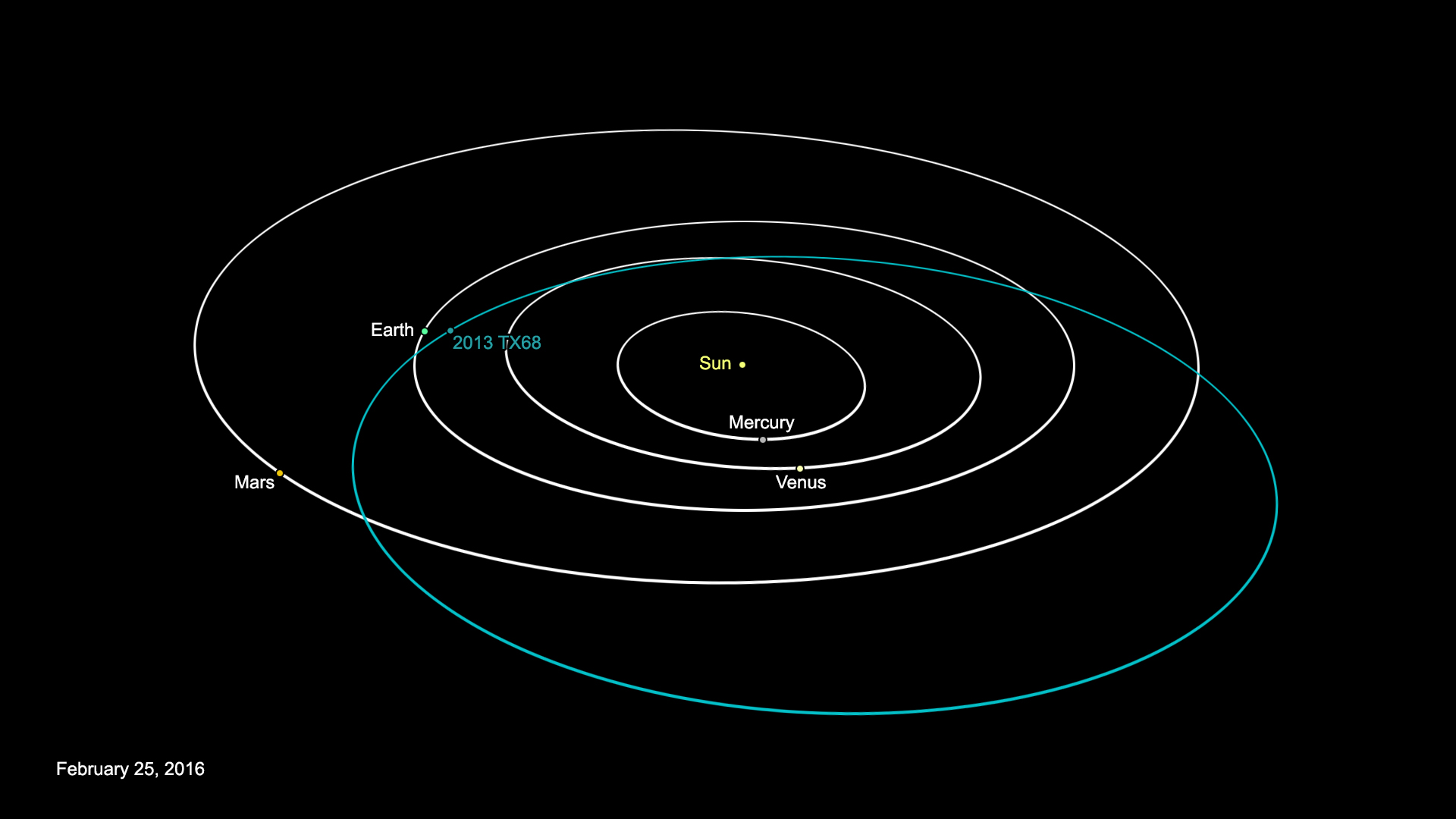UPDATED ON FEB. 25 AT 2:40 P.M. PT:
Additional observations of asteroid 2013 TX68 have been obtained, refining its orbital path and moving the date of the asteroid’s Earth flyby from March 5 to March 8.
The observations, from archived images provided by the NASA-funded Pan-STARRS asteroid survey, enabled scientists at NASA’s Center for Near-Earth Object Studies (CNEOS) at the Jet Propulsion Laboratory in Pasadena, California, to refine their earlier flyby and distance predictions, reconfirming that the asteroid poses no threat to Earth.
“We already knew this asteroid, 2013 TX68, would safely fly past Earth in early March, but this additional data allow us to get a better handle on its orbital path,” said Paul Chodas, manager of CNEOS. “The data indicate that this small asteroid will probably pass much farther away from Earth than previously thought.”
Marco Micheli of the European Space Agency’s NEO Coordination Centre (NEOCC/SpaceDys) in Frascati, Italy, is the astronomer who identified the object in the archived images, measured its position, and provided these observations to the Minor Planet Center in Cambridge, Massachusetts.
CNEOS’s new prediction for 2013 TX68 is that it will fly by roughly 3 million miles (5 million kilometers) from our planet. There is still a chance that it could pass closer, but certainly no closer than 15,000 miles (24,000 kilometers) above Earth’s surface. The new observations also better constrain the path of 2013 TX68 in future years; CNEOS has determined that 2013 TX68 cannot impact Earth over the next century.
“There is no concern whatsoever regarding this asteroid – unless you were interested in seeing it with a telescope,” said Chodas. “Prospects for observing this asteroid, which were not very good to begin with, are now even worse because the asteroid is likely to be farther away, and therefore dimmer than previously believed.”
Orbit calculations of asteroids are constantly updated based on observations reported to the Minor Planet Center. This results in projections of minimum, maximum and nominal distances from Earth, which can sometimes have a wide disparity due to limited data. Over time, with additional observations added to the equation, scientists are able to refine and narrow the orbit uncertainties.
Original story below is from Feb. 2, 2015. Some details from this version are now outdated.
A small asteroid that two years ago flew past Earth at a comfortable distance of about 1.3 million miles (2 million kilometers) will safely fly by our planet again in a few weeks, though this time it may be much closer.
During the upcoming March 5 flyby, asteroid 2013 TX68 could fly past Earth as far out as 9 million miles (14 million kilometers) or as close as 11,000 miles (17,000 kilometers). The variation in possible closest approach distances is due to the wide range of possible trajectories for this object, since it was tracked for only a short time after discovery.
Scientists at NASA’s Center for NEO Studies (CNEOS) at the Jet Propulsion Laboratory in Pasadena, California, have determined there is no possibility that this object could impact Earth during the flyby next month. But they have identified an extremely remote chance that this small asteroid could impact on Sep. 28, 2017, with odds of no more than 1-in-250-million. Flybys in 2046 and 2097 have an even lower probability of impact.
“The possibilities of collision on any of the three future flyby dates are far too small to be of any real concern,” said Paul Chodas, manager of CNEOS. “I fully expect any future observations to reduce the probability even more.”
Asteroid 2013 TX68 is estimated to be about 100 feet (30 meters) in diameter. By comparison, the asteroid that broke up in the atmosphere over Chelyabinsk, Russia, three years ago was approximately 65 feet (20 meters) wide. If an asteroid the size of 2013 TX68 were to enter Earth’s atmosphere, it would likely produce an air burst with about twice the energy of the Chelyabinsk event.
The asteroid was discovered by the NASA-funded Catalina Sky Survey on Oct. 6, 2013, as it approached Earth on the nighttime side. After three days of tracking, the asteroid passed into the daytime sky and could no longer be observed. Because it was not tracked for very long, scientists cannot predict its precise orbit around the sun, but they do know that it cannot impact Earth during its flyby next month.
“This asteroid’s orbit is quite uncertain, and it will be hard to predict where to look for it,” said Chodas. “There is a chance that the asteroid will be picked up by our asteroid search telescopes when it safely flies past us next month, providing us with data to more precisely define its orbit around the sun.”
For regular updates on passing asteroids, NASA has a list of the next five close approaches to Earth; it links to the CNEOS website with a complete list of recent and upcoming close approaches, as well as all other data on the orbits of known NEOs, so scientists and members of the media and public can track information on known objects.
For more information on NASA’s Planetary Defense Coordination Office, visit:
https://www.nasa.gov/planetarydefense
For asteroid news and updates, follow AsteroidWatch on Twitter:
DC Agle
Jet Propulsion Laboratory, Pasadena, California
818-393-9011
agle@jpl.nasa.gov
2016-033





























